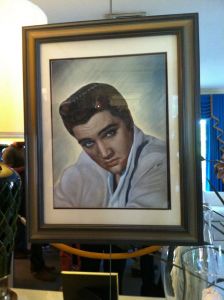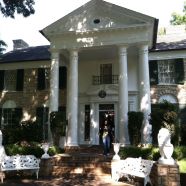Last Ride to Graceland
I got the idea for my next novel while lying in bed one morning skimming the Sunday paper. A headline jumped out at me: “Last Ride to Graceland,” along with an article about the car Elvis Presley drove on the last day of his life. It was a 1973 Stutz Blackhawk, the ultimate muscle car, and the article said only that the vehicle had been “wrapped up like a time capsule” since Elvis died, but was now going to be restored and returned to Graceland.
Here’s the weird part. I’ve never been an Elvis fan. But something about the situation grabbed at me, especially the words “time capsule,” and by lunchtime I’d sketched out the arc of a story. How Cory Ainsworth, the daughter of one of Elvis’s backup singers, finds the car in the family’s abandoned fishing shed after her mother’s death. There’s no explanation for how the Blackhawk comes to be there but Cory decides to drive it back to Graceland, using the trash she finds in the car to retrace the route her mother made thirty-seven years earlier, when she frantically fled Memphis on the day Elvis died.
My editor bought it on the premise alone, without me writing a single word, which was my first hint that everybody loves Elvis, even the people who don’t like Elvis. He just has this ubiquitous quality, equal parts all-American success story and Greek tragedy. So, method writer than I am, I immediately set out on a research road trip, driving from Beaufort, South Carolina, to Memphis, Tennessee, with stops in Macon, Georgia, Fairhope, Alabama, and Tupelo, Mississippi. I took my dog along because, hell, I figured I just had to.
Don’t get me wrong. I was driving a Prius, not a muscle car, and Thad is a yappy terrier mutt, not the soulful coon hound I envisioned as Cory’s traveling companion. But I encountered my share of beer joints, evangelists, strippers, shrimp, cypress trees, truck stops, and poets during my week-long drive across the deep South and I arrived at Graceland with a pretty good grip on my story. But I still had only a tenuous idea of the role Elvis himself would play in it and a single day at Graceland to bring him into focus.
Everyone says the same two things about Graceland: That it’s much smaller than you’d expect it to be and that it’s tacky. And both of those things are true, but it is also one of the best museums of contemporary culture you’ll find, eerily skillful at playing on both the memories and the emotions of its visitors. I’m convinced that Graceland can tell you more about the American dream than the White House, Grand Canyon, and Statue of Liberty combined.
There’s two parts: the house itself and the museum compound, where you park and buy your tickets and walk through a series of exhibit halls, each themed to correspond to a segment of Elvis’s life. There’s his hardscrabble Tupelo childhood, the first raw recordings at Sun Studio, Elvis in the army, in the movies, and in Vegas. (Fun fact: Elvis was a white boy who sounded black, so in the segregated South the record company didn’t know what to do with him. They released his first single with a “white song” on one side and a “black song” on the other. Both sides went to number one, making Elvis the first crossover artist of his time, a singer who appealed equally to both races. He always had both black and white backup singers as a nod to the twin sides of his musical roots.)
Each section of the museum features the music and clothing of that period, with TVs pounding out the news stories of the time, and for a baby boomer like myself, it wasn’t like I was reliving Elvis’s life as much as it was like I was reliving my own. It’s simple, but damn effective. I became so stoned on memory that I almost bought a twenty-six-dollar Christmas ornament in the gift shop, before sanity intervened and I settled for a banana and peanut butter milkshake—no judgment—in the diner next door.
In the car museum I shamelessly played the “I’m a writer” card. They had a Blackhawk on display . . . not the one he drove on the day of his death, which was still being restored, but the model from the year before, which my research had assured me was almost identical to the car so central to the plot of my book. It was on a pedestal and roped off, with the doors open and mirrors placed to give you a glimpse of the interior red leather seats and 24-carat gold fixtures. I lurked around the Blackhawk so long that one of the staff noticed and, when I told him I’d driven all the way from Charlotte just to see this car he dropped the velvet movie-style rope and led me up to it.
“Touch that leather,” he said, his voice reverent, but he wouldn’t let me climb inside. We’d drawn quite a crowd and the man’s boss was frowning at us.
So I thanked him, left the museum, grabbed my headsets, and got on the shuttle for the brief ride across the road and through the famous wrought iron gates of Graceland. I was the only person on my bus who spoke English. There was a large group of Japanese businessmen who, judging by the size of their bags, had not been as stingy in the gift shop as me. The other half of the shuttle was occupied by a multigenerational German family. One of the women was already weeping.
The tour is pretty much what you’d expect. The headphones tell you the basics about each room, and if you want to know more about a particular item, whether it’s a portrait or award or piece of memorabilia, you can press the number beneath it for additional information. My tour group was nothing if not thorough. They pressed every button and took pictures of each item, including the appliances in the kitchen, which looked exactly like the kitchen I grew up in, right down to the avocado green refrigerator.
I got pretty far ahead of them and was the first to arrive at the media hall, a large room packed with people and built on the back of the house to serve as the termination point of the tour. They keep you moving steadily through Graceland proper, with its tight mazes of halls, but people can linger as long as they like in the media hall. And linger they do, a patchwork of every race, age, nationality, and economic level, all gazing up open-mouthed at the floor-to-ceiling screens showing concert footage from the Vegas years. Graceland is careful not to tarnish the man’s image, but I knew from my research that by this point in Elvis’s career, he was in full decline—he often forgot song lyrics, and at times his voice gave out altogether. His backup singers had been trained to rescue the show, slipping into the melody with their own voices to support him when he faltered or actually pulling him back to his feet when one of his karate moves went awry. The Elvis on the screens above me was already fat, bloated, dazed, and sweaty, a sad parody of the beautiful boy who had serenaded us at the beginning of the tour.
But here’s the thing about Elvis. Even at his lowest point, he still had those occasional times when he was on, and when he was on, he was magic. At one point the screens lit up with him larger than life in a white jumpsuit singing “The Battle Hymn of the Republic” and I defy anyone to remain goosebumpless under such an onslaught. Water was pouring off the man and his eyes were squeezed shut. The hand gripping the microphone was encrusted with ridiculously large rings and the camera angle was unfortunate. He was no more than a year away from his death, and yet when he moved into the heart of the song, I forgot that I didn’t really like Elvis and that Graceland was tacky and began to cry. By the time he got to the “glory, glory hallelujah” part, half the room was openly sobbing and then the Germans came in and completely lost their shit.
 My favorite quote about America is Oscar Wilde’s claim that we are “the only country that ever went from barbarism to decadence without an intervening period of civilization.” The same could be said about Elvis Presley. The man moved from poverty to excess with dizzying speed, from thin to fat, from poor to rich, from innocent to tainted, and there never seemed to be a time in his life when he wasn’t either sharply rising or sharply falling. And yet he also has, like the country that birthed him, a certain simple sweetness that lies beneath the glittery surface. It makes us love him. Even when we don’t always want to.
My favorite quote about America is Oscar Wilde’s claim that we are “the only country that ever went from barbarism to decadence without an intervening period of civilization.” The same could be said about Elvis Presley. The man moved from poverty to excess with dizzying speed, from thin to fat, from poor to rich, from innocent to tainted, and there never seemed to be a time in his life when he wasn’t either sharply rising or sharply falling. And yet he also has, like the country that birthed him, a certain simple sweetness that lies beneath the glittery surface. It makes us love him. Even when we don’t always want to.








Wonderful story! I love the deatail, the humor and the pathos. You managed to provke both laughter and tears. Looking forward to the book.
I definitely enjoyed reading this and look forward to the book. I was an Elvis fan, but not to the crazed, crying teenager venue. I just liked listening to some of his music.
Loved this. Loved the book!
This was an excellent read. I’ve visited Graceland, I’ve listened to Elvis, and I grew up in Carolina. Now that none of those things are in my daily orbit, I am so glad I found this book. It was the breath of fresh air I needed. Thank you, Kim Wright!